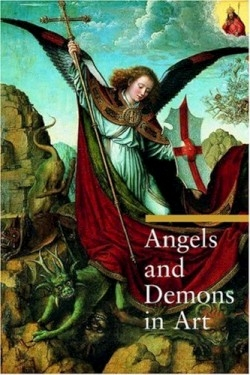Angels and Demons in Art
In a painting by Raphael, Saint George rides forth from a town on his white horse and slays a hideous, voracious dragon. Or … is that Saint Michael, who also slew vicious mystical beasts? Viewers in Renaissance times would have been able to tell at a glance which saint was the hero of the story being told in the painting, because they would have been familiar with the religious symbolism that the artist employed.
This informative art guide lets modern readers in on the secret code of symbolism in classical art. It is the most recent installment in the J. Paul Getty Museum’s “A Guide to Imagery” series; earlier entries include Saints in Art (by the same author), plus Symbols and Allegories in Art, Nature and Its Symbols, and more. The series provides easy-to-use reference material that helps art lovers and history buffs understand the significance of symbols commonly used in paintings and sculptures throughout history.
The author, an art historian specializing in iconography, has previously written books on Caravaggio, Velázquez, and El Greco. Here, she illuminates with great clarity the symbolism surrounding the depiction of mystical creatures, both good and evil, and the roles they play in art and religion. The original Italian is gracefully rendered in English; the translator has previously worked on books about Mayan civilization, as well as Italian art, calligraphy, and biography books.
In Raphael’s time, Giorgi explains, art viewers would have known that Saint George is identified by the white horse he rides. Saint Michael, on the other hand, is known as the commander of the heavenly cohorts, and is always portrayed wearing armor. George’s white horse symbolizes the purity of his spirit; the town depicted in the background is the municipality that George converted to Christianity after heroically killing the dragon. The beast symbolizes evil; demons are often rendered with horns, Giorgi explains, which refers to the horned pagan god Pan (early Christianity strove to suppress previous, nature-based religions). Raphael was conveying the message that when the saint slays the dragon, he is actually defeating evil and unbelief, opening the way for the townspeople to follow the Christian path of salvation.
This guide, replete with such educational detail, is sized to be carried easily through a museum or gallery (5 x 7 inches) and logically arranged to make it simple for a viewer to find an explanation of art elements like guardian angels or depictions of the Apocalypse. Each of the book’s six sections is marked in the upper corner by a thumbnail reproduction of a painting that exemplifies that category; for instance, the section called “The Path to Salvation” is marked by a detail of Raphael’s Saint George and the Dragon and “The Last Days: Judgment and Reality” by Michelangelo’s Christ the Judge and Madonna.
Within each category, Giorgi lists sub-topics (like “Cherubim” or “The Seven Deadly Sins”), and provides a few paragraphs describing each element and its place in the history of art and writing. Several works of art containing that symbol are then displayed, surrounded by nuggets of information explaining the meaning of the art, and helpful arrows pointing out the symbols. She organizes the artworks chronologically, demonstrating the symbols’ artistic evolution. The book is printed on glossy paper, giving a clear sheen to the art reproductions.
The facts included are exhaustive, but because the author does not elucidate every image in every painting, readers seeking a deeper understanding of certain symbols may need to do some searching throughout the volume. The two indices (a general one and an index of artists) will aid in this endeavor. Also, each sub-topic is helpfully summarized in the margin, specifying the definition of the topic, its Biblical sources and related literature, and the diffusion of the image in art throughout the ages.
Understanding the deeper intended meaning in classical art will greatly enhance modern viewers’ experience. An additional index arranged according to the location of the artworks would have been a valuable extra; then when readers go to the Met or the Sistine Chapel, they could tuck this gorgeous, instructive volume in a pocket, find all the paintings there that Giorgi mentions, and expound knowledgeably to their companions about angelic and demonic symbolism.
Reviewed by
Karen McCarthy
Disclosure: This article is not an endorsement, but a review. The publisher of this book provided free copies of the book to have their book reviewed by a professional reviewer. No fee was paid by the publisher for this review. Foreword Reviews only recommends books that we love. Foreword Magazine, Inc. is disclosing this in accordance with the Federal Trade Commission’s 16 CFR, Part 255.

